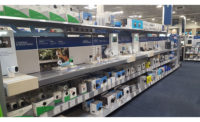Report: Smart Home Consumers Prefer ‘Do It for Me’ Over Doing It Themselves

In its new Smart Home 360 report, Argus Insights reveals a strong distinction between consumer perception of the apps associated with the most popular smart home service providers and MSOs (multiple system operators) and the apps coming with do-it-yourself (DIY) devices.
In its analysis, Argus Insights found that from more than 56,000 app and device reviews, ADT and Suddenlink are the least liked of MSOs and service providers and their associated apps saw a drop in both the tone and volume of feedback over the last month, an indication that frustrated users could be moving to other providers. However, Vivint’s Sky app, Cox Communications Homelife app, Xfinity Home app and Alarm.com app all trended up, an impact of both new releases and subscriber growth.
While Vivint Sky has slipped slightly in user preference in the past three months, after a drop for AT&T Digital Life and Time Warner, Vivint remains the most loved of the service provider apps consumers use to control their smart homes. Xfinity Home made notable gains after it released a new version of its app at the end of March, addressing customer issues with stability and remote access of camera feeds.
“While some people enjoy the challenge of setting up their own devices, our data shows that delight comes when the consumer is relying on service providers — at least for now — to do all the installations and connecting,” said John Feland, CEO, Argus Insights. “The continued dominance of Vivint, and significant improvements by Xfinity demonstrate the impact of proactively engaging with customers on improving the user experience.”
Additionally, the reviews show a significant difference between service providers and DIY experiences. Customers of service providers focus three times more on home security than DIY customers. DIY users have climate control as the top-of-mind usage. According to the report, when home security is eliminated, the relative ranking of smart home uses is largely the same.
“We see smart home adoption being driven by three factors: fear, fun and function. For service providers, the fear factor drives home security as the key reason for purchase and use,” said Feland. “DIY consumers blend function and fear, with climate control being typically the gateway smart home experience.”
The full report is available for purchase and analyzes:
- the smart home categories experiencing the most demand momentum from consumers;
- which retail channel is doing the best job of communicating the value of smart home;
- the brands dominating the social conversation on Twitter and the strategies that work best; and
- which service providers are gaining subscriber momentum (this section is available for download).
Visit www.argusinsights.com to purchase the report.
Looking for a reprint of this article?
From high-res PDFs to custom plaques, order your copy today!





